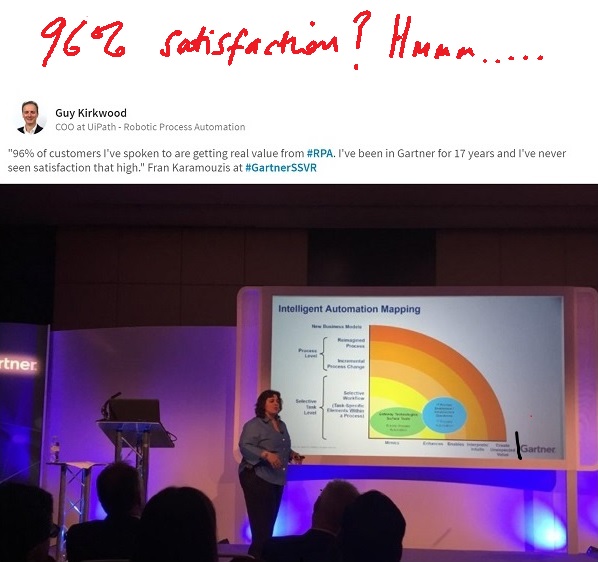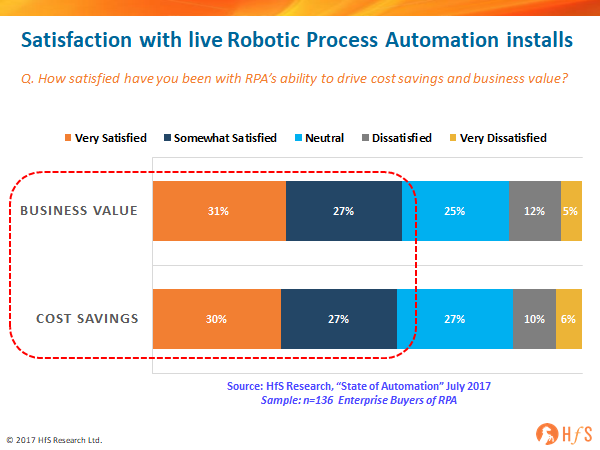When we revealed Gartner’s bullish 96% of clients are getting real value from RPA bombshell (see post) six weeks ago, everyone close to the action was incredulous:

Now we have the real data to prove where satisfaction levels currently sit, where we interviewed 136 major enterprises currently experiencing RPA installs:

My personal experience has tended to be about half of enterprise RPA clients today are experiencing positive progress, while the other half are struggling or aborting RPA projects altogether, so this data is pretty positive, especially when you consider that the same number are positive about both the cost and business impact of RPA.
The Bottom-line: RPA is making sense in this era of renovation and the current satisfaction results reflect this
What I love about RPA is the fact it’s making us fix a lot of the systems we’re currently stuck with, using sensible, affordable technology. We spent years bemoaning the fact that enterprises couldn’t just “saw off” their broken processes and replace with costly new systems and services, but the reality is that most enterprises are not ready to write off their technical debt and invest in change, especially when the outcome is not particularly clear. What is clear is that most enterprises prefer to invest in making their broken processes function better, operating in a digital fashion where they can manage the change themselves and the cost isn’t abhorrent. Taking it one broken process at a time, fixing it, proving the ROI then onto the next one is the step change strategy that is working for the majority.
Yes, RPA is predominantly operating as a retro-fit solution for most enterprise clients, getting rudimentary processes functional by eliminating high-throughput, high-intensive manual interventions and helping applications and systems manage digital workflows effectively. Yes, RPA keeps legacy alive for many organizations, but in a way that you can build digital overlays over these systems, once the manual elements are eliminated and workflows are joined up effectively. Our emerging conversation, beyond RPA, is all about automating the automation and deriving the right data patterns to promote more intelligent machine learning and cognitive capabilities.
The good news is the general adoption of RPA is on the right path and the next challenge for enterprises is to figure out the next wave of digital building blocks to drive more intelligent and predictive capabilities into their data backbone. Software firms, advisors and service providers alike all have to create much more dynamic partnerships to help enterprise their clients get to this stage – this is much more about how to start innovating together and understanding each others’ capabilities. Just talk to any services provider, such as an Accenture, Genpact, IBM, TCS or Wipro etc., and they will tell you a whole new plethora of smart digital competitors are emerging and you just can’t afford to acquire them all – you need to learn how to work with them and give them some skin in the game.
We’re in an era when technological needs are complex, and there is no defined rulebook explaining how to develop a holistic data strategy. We’re in an era of discovery and making the most of what we currently have, before we can truly understand what we will need to be successful at some far-flung point in the future. In my view, being “disrupted” is when you don’t collaborate and explore… being a disruptor is being forever bold and unafraid, in order to define your own curriculum as this digital future unravels. Stay tuned for a lot more analysis from this study…
Posted in : Cognitive Computing, Robotic Process Automation, the-industry-speaks






About right there Phil on the numbers. Interesting will be on the numbers of unattended bots / automated hours organizations actually achieved. Less than 1% of manual work of entire work force ? 1/10th of that even?
Little too is being said about the growing cost of keeping these legacy systems alive and now you have to accommodate the change control around the UI as well for scraping against them. Onwards.
To confirm your other point, a Fintech exec said, proposing automating a process using RPA is making IT come back with other strategic ways to solve the problem once automation suggestions highlight what the problem really is..
Ideally, I would like to see that number improve well above 58%. RPA brings great value…if implemented well.
Phil – good data and feels exactly right when you talk with clients. You are making a career out of making Gartner look amaterish 🙂
@Francis – It’s a good argument that RPA is forcing IT into looking at other solutions than simply papering over the cracks in the legacy, but the bottom line is most clients have proven time and time again they just don’t have the patience and investment to make “one big bang” overhaul to back office processes.
I’ll share some data shortly that shows most activity is really at the very rudimentary level (customer service and F&A) where manual efforts are still far too prominent and clients are looking more at cost takeout, whereas satisfaction is highest in areas that really touch the business value, namely marketing and IT help desk, where the focus is more on improved performance than merely cost and efficiency,
PF
@Craig – have seen around a third of pilots getting botched because clients are approaching it all wrong – not looking at RPA ‘one process at a time’, not thinking about milestones and a workable governance mechanism. Many are looking for a ‘silver bullet’ that simply doesn’t exist… this is software like anything else and needs a proper investment plan. I blame too many poor advisors and hyped media…
PF
Phil,
I am curious about the 42%. I would like to know what percentage of this figure represents companies that are implementing on their own with a COE (Center of Excellence). We run into too many clients that put the automation out for bid and then get greedy and assume they can implement themselves for a lot cheaper. This is partly due to the fact that the RPA software vendors sell their product as so easy anyone can do the programming.